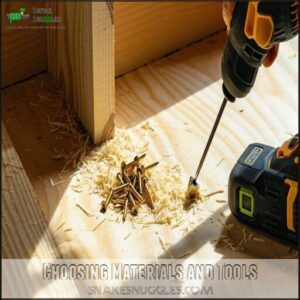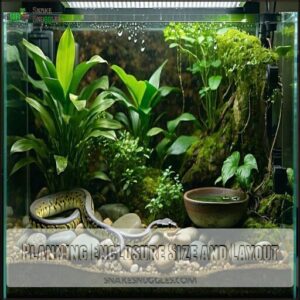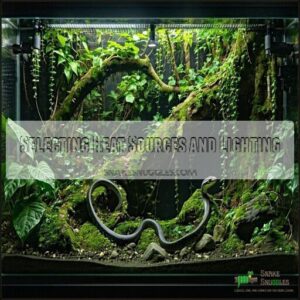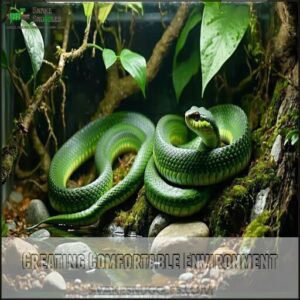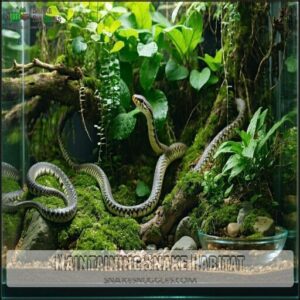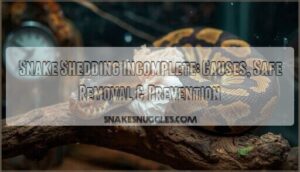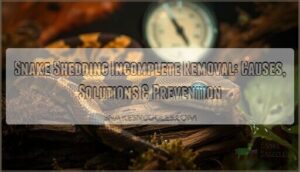This site is supported by our readers. We may earn a commission, at no cost to you, if you purchase through links.

Start with a sturdy enclosure made from oak or plywood that’s sized to match your snake’s length.
You’ll need proper ventilation, a thermal gradient (fancy talk for warm and cool zones), and UVB lighting to keep your snake healthy.
Install a reliable thermostat to control heat lamps and mats, just like a mini climate control system.
The right substrate choice makes all the difference – and wait until you discover the clever tricks for maintaining the perfect humidity levels!
Table Of Contents
- Key Takeaways
- Building Snake Terrarium
- Making Snake Terrarium Habitat
- Designing Safe Enclosures
- Creating Comfortable Environment
- Maintaining Snake Habitat
- Frequently Asked Questions (FAQs)
- How to set up a terrarium for a snake?
- What is the best material for snake enclosures?
- How to create a snake habitat?
- Can a snake live in a terrarium?
- How do you make a terrarium for a snake?
- Do snakes need a terrarium?
- How do I choose a snake terrarium?
- What is a snake terrarium?
- How to make your own terrarium habitat?
- How do I Make my snakes home a vivarium?
- Conclusion
Key Takeaways
- You’ll create a comfortable home for your snake by building a terrarium with proper ventilation, a thermal gradient, and UVB lighting to keep it healthy.
- You’re going to choose the right materials, like wood or glass, and design a safe, escape-proof space with proper ventilation when making a snake terrarium.
- You’ll need to regularly clean and maintain your snake’s terrarium to keep it healthy and happy, including daily sanitizing, waste removal, and substrate replacement.
- You’ll master terrarium maintenance by monitoring temperature and humidity, handling your snake with care, and making upgrades as needed to create a thriving environment for your pet snake.
Building Snake Terrarium
You’re about to create a comfortable home for your snake, and building a snake terrarium is a fun project that requires some planning and creativity.
By following these steps, you’ll be able to design and build a safe and cozy habitat that meets your snake’s specific needs, and you’ll be enjoying your new pet’s company in no time.
Choosing Materials and Tools
When building a DIY snake enclosure, consider wood selection, tool safety, and material costs.
Choose sturdy woods like oak or plywood for your terrarium construction, ensuring a safe and durable DIY terrarium.
Invest in essential hardware options and terrarium supplies for a successful DIY snake enclosure project.
Proper snake enclosure design is essential for the health and well-being of your snake.
Planning Enclosure Size and Layout
Now that you’ve chosen your materials, let’s plan your snake terrarium’s space and layout.
- Calculate space based on snake length
- Consider enclosure depth
- Think about ventilation design
- Plan for a thermal gradient
When designing the terrarium, consider using proper snake enclosure kits for effective results to create a suitable environment for your snake, ensuring a well-planned snake terrarium.
Selecting Heat Sources and Lighting
When setting up your snake’s terrarium, select heat sources and lighting carefully.
Use heat lamps, UVB lighting, and heat mats to create a thermal gradient, and consider thermostat control for ideal snake heating, ensuring a safe and healthy environment for your reptile.
A proper temperature gradient is essential for your snake’s well-being, with proper terrarium heating and lighting for reptiles.
Making Snake Terrarium Habitat
Now that you’ve got your enclosure, how will you turn it into a thriving snake terrarium? Start by considering your snake’s specific needs, like substrate choice and heating setup.
Research your species to determine the best enclosure design and enrichment ideas. Proper ventilation is important for a healthy snake enclosure environment.
A well-designed snake terrarium habitat requires attention to detail, from substrate selection to heating and lighting. Choose a suitable substrate, like aspen or coconut fiber, and set up a heating system that meets your snake’s needs.
With careful planning, you’ll create a comfortable and stimulating environment for your pet snake, making your terrarium setup a success, which is the key to a happy and healthy pet snake.
Designing Safe Enclosures
You’re about to create a safe and comfortable home for your snake, and designing the enclosure is an essential step.
You’ll need to evaluate factors like the type of opening, secure latches, and glass panel installation to guarantee your snake’s habitat is both safe and enjoyable.
Top or Side Opening Considerations
When designing your snake terrarium, consider:
- Top openings for escape prevention
- Side openings for easier cleaning
- Ventilation systems for snake safety, securing latches and a well-ventilated terrarium design for your reptile terrarium setup.
To make sure a safe environment, consider the snake habitat needs when planning your terrarium.
Securing Enclosures With Hinges and Latches
When building your snake enclosure, focus on securing it with reliable locking mechanisms, like secure fasteners and hinge types, to guarantee closure safety, an essential aspect of terrarium design for a DIY snake.
To achieve ideal snake health, consider secure enclosure features that prevent escapes and ensure proper ventilation.
This will help in creating a safe environment, emphasizing the importance of a secure enclosure.
Glass Panel Installation and Safety
When installing a glass panel, consider safety precautions.
Key steps include:
- Glass Cutting
- Panel Sealing
- Secure Fastening
- Escape Prevention
Safety precautions are especially crucial for your terrarium, ensuring a secure glass container for snake terrarium maintenance and terrarium decoration ideas snake, prioritizing snake terrarium safety.
Creating Comfortable Environment
You’re now going to create a comfortable environment for your snake, which is important for its well-being and happiness.
By selecting the right substrate, adding a water dish and heat lamp, and installing a thermometer and humidity control, you’ll be able to provide your snake with a cozy and healthy space to thrive.
Substrate Selection and Vegetation
Choose a suitable substrate for your snake, like coconut fiber or natural dirt, and select plants safe for snake terrariums, considering humidity control and vegetation placement to create a comfortable environment.
Proper snake care involves understanding reptile substrate options to maintain a healthy habitat, with the right substrate types and soil choices for your reptile substrate needs.
Adding Water Dish and Heat Lamp
You’re setting up your snake’s terrarium. Consider these 5 things:
- Water placement
- Heat sources
- Lamp safety
- Dish size
- Temperature control, and place the water dish on the "cold" side, with a heat lamp above the heat mat for effective temperature control.
When creating a comfortable environment, understanding temperature gradients is essential for the snake’s well-being.
The proper setup is crucial for maintaining a healthy environment, and it includes considering the temperature gradients in the terrarium.
Installing Thermometer and Humidity Control
When creating your snake’s terrarium, you’re taking control of their climate.
Place thermometers and humidity sensors strategically for accurate temperature control and moisture levels, ensuring a safe reptile environment through precise climate monitoring and terrarium maintenance, which involves precise control over the environment.
Maintaining Snake Habitat
You’ll need to regularly clean and maintain your snake’s terrarium to keep it healthy and happy.
By monitoring temperature and humidity, handling your snake with care, and making upgrades as needed, you’ll be able to create a thriving environment for your pet snake.
Regular Cleaning and Maintenance
You’ll master terrarium maintenance.
Here are key tasks:
- Daily sanitizing
- Waste removal
- Substrate replacement, ensuring a clean habitat for your snake through proper disinfection methods and regular terrarium upkeep, including daily reptile cleaning and humidity control.
Through these tasks, you will ensure a clean habitat for your snake, utilizing proper disinfection methods for regular terrarium upkeep.
Monitoring Temperature and Humidity
To monitor temperature and humidity, you’ll use thermometers and hygrometers, tracking temperature gradients and humidity levels.
To maintain your snake’s comfort, adjusting heat sources as needed is crucial for ideal temperature control and moisture management in your terrarium.
Handling and Observation Precautions
When handling snakes, prioritize venomous safety and escape prevention.
Observe their behavior, noting body language cues.
In your terrarium for snakes, establish secure reptile enclosure design for safe snake handling and observation, promoting a healthy snake habitat and effective snake care within your carefully created terrarium.
Upgrades and Renovations for Optimal Care
Your snake’s comfort evolves with their needs, just like any home needs occasional updates.
Regular checkups on temperature and humidity levels keep your terrarium in top shape. You’ll want to make adjustments as your scaly friend grows and explores their space.
- Try adding live plants or new climbing branches to boost snake enrichment and natural behaviors
- Upgrade lighting systems to create better thermal gradients
- Experiment with different substrate types for effective humidity control
- Consider expanding the snake terrarium’s size if your pet’s growing quickly, focusing on better thermal gradients and effective humidity control to ensure your pet’s comfort and natural behaviors.
Frequently Asked Questions (FAQs)
How to set up a terrarium for a snake?
Like building a cozy apartment, you’ll need to create distinct zones for your snake.
Start by selecting a secure enclosure, add substrate, install heating and lighting, provide hiding spots, and maintain proper humidity levels.
What is the best material for snake enclosures?
You’ll want to use wood as your primary material since it’s durable and insulating.
Combine it with glass panels for viewing and PVC components for enrichment features.
Don’t forget proper sealant for moisture control.
How to create a snake habitat?
Transform your space into a cozy serpentine sanctuary by setting up a secure enclosure with proper heating, substrate, and hiding spots.
You’ll need a water dish, climbing branches, and temperature monitoring equipment.
Can a snake live in a terrarium?
You can create a suitable terrarium for snakes with proper ventilation, heating, and substrate, but research the specific needs of your species to make sure a safe and healthy environment.
How do you make a terrarium for a snake?
You’ll need a million times more patience, but building a snake terrarium requires choosing the right materials, like wood or glass, and designing a safe, escape-proof space with proper ventilation.
Do snakes need a terrarium?
You’ll likely need a terrarium for your snake, as it provides a controlled environment for temperature, humidity, and lighting, mimicking their natural habitat and ensuring their health and well-being.
How do I choose a snake terrarium?
You’re about to set off on a wild adventure, choosing a snake terrarium that’s a perfect haven.
Considering size, material, and ventilation is crucial to guarantee your slithery friend’s happiness and safety always.
What is a snake terrarium?
You’re building a snake terrarium, basically a secure, escape-proof enclosure mimicking your snake’s natural habitat with controlled temperature, humidity, and lighting.
How to make your own terrarium habitat?
You’ll create a snake terrarium by selecting a suitable enclosure, adding substrate, decorations, and heating/lighting.
Then, you will customize it to meet your snake’s specific needs and preferences for a thriving habitat.
How do I Make my snakes home a vivarium?
You’ll design a vivarium with secure enclosures, proper ventilation, and a heat source, tailoring it to your snake’s specific needs for a safe and healthy environment.
Conclusion
Notably, 75% of snake owners report improved pet health with proper terrariums.
You’re now equipped to create a thriving environment, having learned how to make a terrarium habitat for snakes, complete with ventilation, heat, and UVB lighting.
Making you a great snake parent by following these steps for a happy, healthy snake.
- https://snakesnuggles.com/how-to-make-a-terrarium-habitat-for-snakes/
- https://emborapets.com/how-to-make-a-terrarium-habitat-for-snakes/
- https://www.wikihow.com/Build-a-Snake-Cage
- https://mysnakepet.com/how-to-make-a-terrarium-habitat-for-snakes/
- https://www.instructables.com/How-to-Set-Up-a-Reptile-Terrarium/

